Contemporary Collection
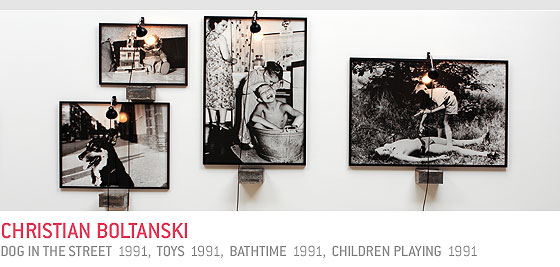 | Christian Boltanski France b1944
Dog in the street 1991
gelatin silver photograph, lamp, biscuit box and electrical wires
Mervyn Horton Bequest Fund 1994 Toys 1991
gelatin silver photograph, lamp, biscuit box and electrical wires
Mervyn Horton Bequest Fund 1994 Bathtime 1991
gelatin silver photograph, lamp, biscuit box and electrical wires
Mervyn Horton Bequest Fund 1994 Children playing 1991
gelatin silver photograph, lamp, biscuit box and electrical wires
Mervyn Horton Bequest Fund 1994 Christian Boltanski often re-photographs found images, mimicking the appearance of old family albums, archives or newspaper clippings. His use of enlarged, black-and-white, documentary-style prints adds to the sense that we are looking at records of real people who once stood in front of the camera, but have since vanished. Under each image there is an old biscuit box, like those stashed in many hall cupboards, containing snapshots of the families represented in the larger photographs. The boxes and reading lamps signal domesticity, while also making the images seem like artificial altars to their illuminated subjects. These works speak of the intimate but problematic relationship between truth, memory and photography. |
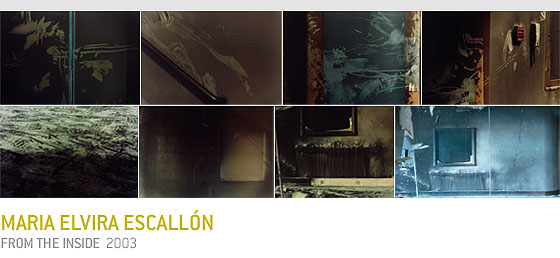 | Maria Elvira Escallón England; Colombia b1954
From the inside #1, 2, 3, 6, 7, 10 & 11 2003, printed 2008
from the series From the inside
type C photographs From the inside 2003
from the series From the inside
12-hour colour video, sound
Mervyn Horton Bequest Fund 2008 On 7 February 2003 a car bomb planted by unknown terrorists killed 36 people in the El Nogal social club in Bogota, Colombia. 200 people were injured and the club contained approximately 600 people at the time of the explosion. Artist Maria Elvira Escallón had worked in El Nogal and was associated with its cultural program. A few days after the attack she went to check on the condition of the club and was moved to record and keep a memory of what she saw. Escallón shows the traces left by those who were in the building during the event, marked in the layers of ash and soot covering the surfaces – signs of the fear and pain that were experienced there. |
 | Bill Henson Australia b1955
Untitled 1994/95 1994-95
from the series Untitled 1994/95
type C photograph, adhesive tape, pins, glassine
Contemporary Collection Benefactors 1996 Untitled 1995/96 1995-96
from the series Untitled 1995/96
diptych: two type C photographs, adhesive tape, pins, glassine
Purchased 1996 Bill Henson’s photographs are often concerned with the junctures between adolescence and adulthood and between darkness and luminosity. Here, naked youths stumble across scrapheaps in a romantic landscape as though they have fallen from paradise into forests of industrial decay. The scene is fractured and the space dislocated by the jagged reversed pieces of photographic paper pinned almost savagely to the surface. Monumental yet intimate, these layered works are full of echoes and displacements as Henson splinters the photographic surface and disrupts the boundaries of the image. |
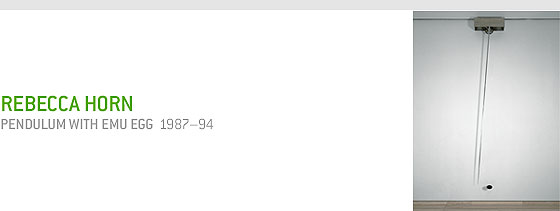 | Rebecca Horn Germany b1944
Pendulum with emu egg 1987-1994
aluminium, emu egg, electric motor
Mervyn Horton Bequest Fund 1994 Rebecca Horn’s works are often about the body and the relationship between nature and mechanisation. Pendulum with emu egg generates both wincing anxiety and relieved pleasure. As it swings, the pendulum threatens to smash into the fragile egg before slowing to almost caress its surface. The elements symbolise the masculine and feminine in a mechanised enactment of sexual desire. The egg can also be seen as representing new life, with the pendulum as a jerky, out-of-kilter metronome that stutteringly marks time and relentlessly withdraws it. The thought of the sharpened needle poised a few millimetres above the egg, ready to pierce it, may remind us of in-vitro fertilisation – another symbol of the tension at the juncture between nature and technology. |
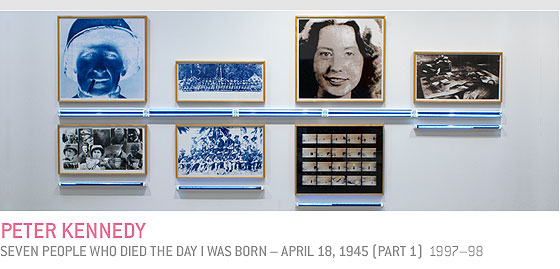 | Peter Kennedy Australia b1945
Seven people who died the day I was born - April 18, 1945 (part 1) 1997-1998
type C photographs, fluorescent tubes with text, metal
Contemporary Collection Benefactors 2003 As its title suggests, this work brings together images of people who died on 18 April 1945 – the day that the artist was born. It is from a series that Kennedy began in 1997 after his father’s death in which he considers the interconnectedness of individual lives and political and historical events. Kennedy’s birth in the last year of World War II sits at a pivotal point in 20th-century history, and here the photographs are imbued with a political resonance. The minimalist fluorescent tubes that divide and connect the images also extend their associations; the seven people memorialised here imply the multitude of others that died during this catastrophic event. |
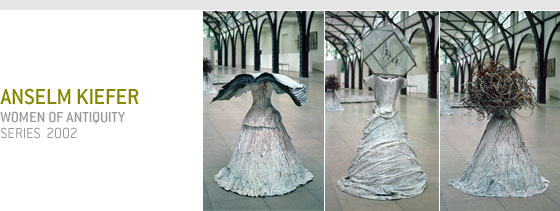 | Anselm Kiefer Germany b1945
(Left to right) Myrtis painted bronze, lead 144 x 133 x 128 cm
Hypatia painted bronze, glass, iron, ash 202 x 118 x 117 cm
Candidia painted bronze, iron 177 x 130 x 125 cm
From the series Women of antiquity 2002 Born in 1945 in Donaueschingen, Germany, Anselm Kiefer is regarded as one of the most important and influential artists working today. Since the early 1970s his work has evolved from a formative interest in exploring critically the fascism of Germany to reflecting history through mythology, wide-ranging materials, and the language of iconography. A recurring interest in Kiefer’s recent work is the treatment many mythologies have handed out to women, particularly women whose strength and intelligence have been seen as unruly or cause for demonisation. In Women of antiquity, he portrays Candida, Myrtis and Hypatia, three women who came to a bad end by competing with men. Each is identified through a key attribute: a lead book in place of her head identifies Myrtis, a Greek poet blamed for competing with Pindar; a glass Melancholia cube represents Hypatia, an Alexandrine philosopher who was brutally murdered in sectarian unrest in 415 CE; and a rusting mass of razor wire signifies Candidia, a Roman witch who wove vipers through her dishevelled hair. |
 | Jannis Kounellis Greece; Italy b1936
Untitled 1984/87 1987
steel, wood, plaster, cloth, gas burner, paint, soot marks
Mervyn Horton Bequest Fund 1988 In Untitled 1984/87, Kounellis combines industrial materials to evoke a series of personal and mythological references that together form a story of human life. The bed frame is an object that accompanies our body when we are born and when we die, the cloth bundles evoke domesticity, and the burning flame represents the transforming, alchemical power of fire. In the Greek city of Piraeus near Kounellis’ birthplace is a cemetery where oil lamps burn on each grave as a symbol of the passage of the spirit. Here traces of soot mark the walls, amplifying the sense that we are looking at the remnants of an abandoned temple, a house that has been burnt, or a life transformed. |
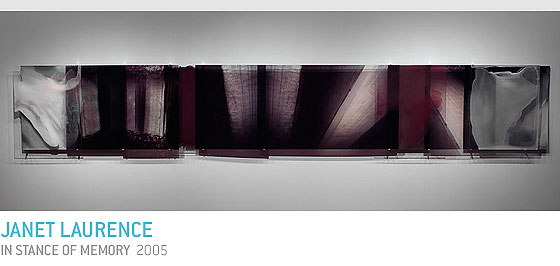 | Janet Laurence Australia b1949
In stance of memory 2005
12 panels: Duraclear on shinkolite, oxides and ash in oil, rusted steel
Contemporary Collection Benefactors 2006 with the assistance of The George Institute for International Health, 2 anonymous donors, Michèle Asprey & Lindsay Powers, Anita & Luca Belgiorno-Nettis, Kemsley Brennan, Bambi & Derek Blumberg, Natalia Bradshaw, Andrew & Cathy Cameron, Mark Clark & John Pearson, Peter English & Fiona McIntosh, James Hill & Jen Dowling, Michael & Doris Hobbs, Neville Keating McIlroy, Stephen MacMahon & Robyn Norton, Lisa & Egil Paulsen, Janet Pennington, Vivienne Sharpe, Andrew D. Smith, Miriam and Les Stein, Deborah Thomas, Michael Whitworth & Candice Bruce, Corinne and John Young, Brian Zulaikha 'I'm interested in how our whole body experiences space; the fact that space and ourselves are enfolded into one another. It's about how our memory – our past and immediate memory – affects everything.' Janet Laurence Between the panels of this work, Laurence has layered images of a courtyard at the Jewish Museum in Berlin. The courtyard has been designed so that visitors emerge into an outdoor space in which trees grow out of the top of concrete columns. The columns feel claustrophobic and disorientating and visitors look up to see distant leaves and sections of sky, symbolising nature and life. Laurence layers these images with clouded reflective surfaces and poured chemical spills, veiling and revealing, evoking memory and tragedy. |
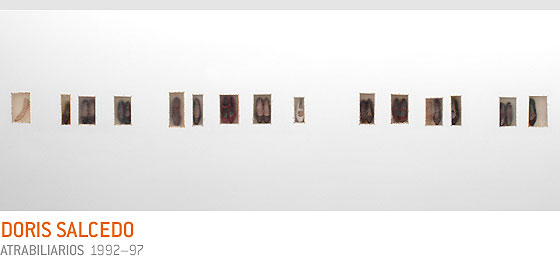 | Doris Salcedo Colombia b1958
Atrabiliarios 1992-1997
timber, gyproc, cow bladder, shoes and surgical thread
Mervyn Horton Bequest Fund 1997 In Atrabiliarios, niches cut into the plaster wall contain shoes as relics or attributes of lost people. The artist has sealed the openings with membranes of cow bladder which she has stitched into the plaster with surgical thread, as though repairing torn skin. Shoes carry the mark of our bodies more than any other item of clothing and Atrabiliarios is about bodily memory – its shapes, traces, and imprints. The work also has a strong resonance with the artist’s personal history. In her native Colombia, people often just disappear, held hostage by drug barons or by government-backed militia. Salcedo has lost members of her own family in this way. These shoes were donated by the relatives of those who have been taken. |
 | Ken Unsworth Australia b1931
Rapture 1994
piano, straw, burnt music sheets, plastic mice
Winifred Vere Hole Bequest Fund 1994 Rapture both promises and denies a transcendent musical experience – a melodic stairway to heaven that never eventuates. We imagine striding up the keyboard stairs to a realm populated by harp-playing angels; instead at the top we get a muffled piano full of straw and inhabited by pesky mice. The only composition written on this instrument is that of the mice tripping down the stairs in playful and incoherent staccato. Burnt music sheets at the top of the piano lend the work a melancholic air, hinting at the connection between music and emotional memory. Unsworth is interested in personal and collective symbolism, as well as the formal qualities of a sculpture that seems poised simultaneously to slide and levitate. |
|